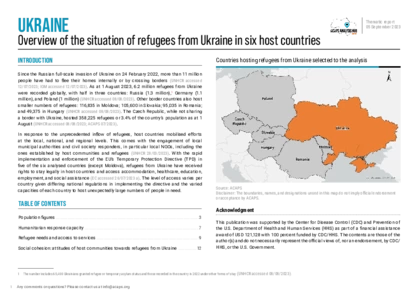Armed conflict between Russia and Ukraine started in 2014 after Russia invaded Crimea in southern Ukraine and, later that year, the eastern Donetsk and Luhansk oblasts. The conflict escalated in February 2022 when Russia launched a full-scale invasion from Russian and Belarusian territory into northern, eastern, and southern Ukraine, resulting in mass displacement within Ukraine and abroad.
Initially, an influx of more than 700,000 people from Ukraine escaped conflict to or through Moldova. As at 6 September 2023, 117,000 refugees from Ukraine remained in the country, with most staying with host families. On 1 March 2023, the Government of Moldova activated a temporary protection programme for refugees.
In October 2022, Russia cut off gas supplies to Moldova, leading to a spike in energy prices and basic commodity prices. Political and economic pressure from Russia adds to security concerns related to attempts to destabilise the EU-oriented leadership in Moldova, as well as the Russian military presence and control of Transnistria, a region in eastern Moldova bordering Ukraine, which the Council of Europe designated in 2022 as occupied by Russia.
For a regional overview of the legal situation of refugees from Ukraine and access to essential services, please read our latest report.
After the onset of the Russia-Ukraine conflict in 2014, in February 2022, Russia launched a full-scale invasion from Russian and Belarusian territory into northern, eastern, and southern Ukraine. This has resulted in mass displacement within Ukraine and abroad, mostly to the EU.
Initially, an influx of more than 700,000 people from Ukraine escaped conflict to or through Moldova. On 1 March 2023, the Government of Moldova activated a temporary protection programme for refugees. As at 14 January 2024, 120,600 refugees from Ukraine remained in the country, most staying with host families.
Political and economic pressure from Russia adds to security concerns related to attempts to destabilise the EU-oriented leadership in Moldova. The Russian military presence and control of Transnistria, a region in eastern Moldova bordering Ukraine, which the Council of Europe designated in 2022 as occupied by Russia, pose additional challenges.
(Atlantic Council 14/02/2023, UNHCR accessed 29/01/2024, UNHCR 15/01/2024, The Guardian 24/05/2023, BI 16/03/2022)
Armed conflict between Russia and Ukraine started in 2014 after Russia invaded Crimea in southern Ukraine and, later that year, the eastern Donetsk and Luhansk oblasts. The conflict escalated in February 2022 when Russia launched a full-scale invasion from Russian and Belarusian territory into northern, eastern, and southern Ukraine, resulting in mass displacement within Ukraine and abroad.
Initially, an influx of more than 700,000 people from Ukraine escaped conflict to or through Moldova. As at 6 September 2023, 117,000 refugees from Ukraine remained in the country, with most staying with host families. On 1 March 2023, the Government of Moldova activated a temporary protection programme for refugees.
In October 2022, Russia cut off gas supplies to Moldova, leading to a spike in energy prices and basic commodity prices. Political and economic pressure from Russia adds to security concerns related to attempts to destabilise the EU-oriented leadership in Moldova, as well as the Russian military presence and control of Transnistria, a region in eastern Moldova bordering Ukraine, which the Council of Europe designated in 2022 as occupied by Russia.
For a regional overview of the legal situation of refugees from Ukraine and access to essential services, please read our latest report.
After the onset of the Russia-Ukraine conflict in 2014, in February 2022, Russia launched a full-scale invasion from Russian and Belarusian territory into northern, eastern, and southern Ukraine. This has resulted in mass displacement within Ukraine and abroad, mostly to the EU.
Initially, an influx of more than 700,000 people from Ukraine escaped conflict to or through Moldova. On 1 March 2023, the Government of Moldova activated a temporary protection programme for refugees. As at 14 January 2024, 120,600 refugees from Ukraine remained in the country, most staying with host families.
Political and economic pressure from Russia adds to security concerns related to attempts to destabilise the EU-oriented leadership in Moldova. The Russian military presence and control of Transnistria, a region in eastern Moldova bordering Ukraine, which the Council of Europe designated in 2022 as occupied by Russia, pose additional challenges.
(Atlantic Council 14/02/2023, UNHCR accessed 29/01/2024, UNHCR 15/01/2024, The Guardian 24/05/2023, BI 16/03/2022)



